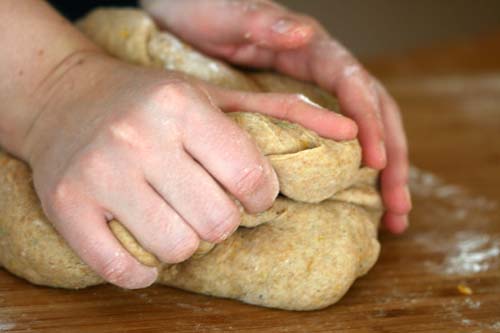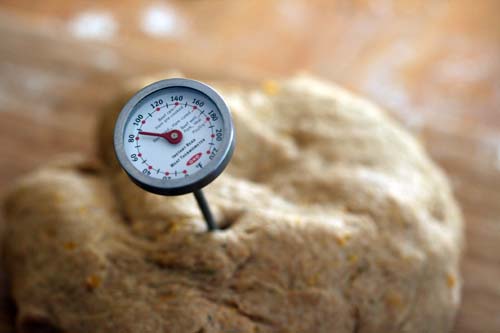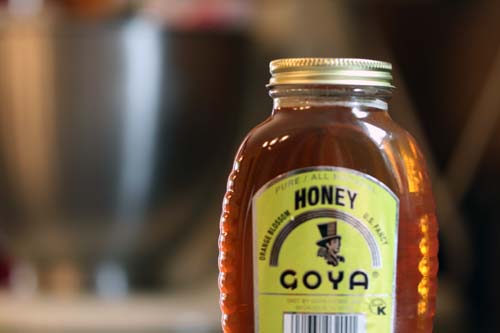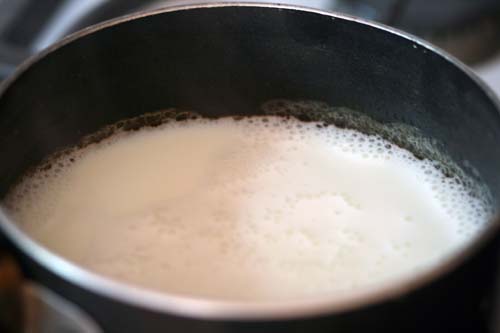Round Five — Cheese Bread

There’s been a lot of change in my life lately.
And by lately, I mean for nearly a year.
And by change, I mean big change.
Last November, I got engaged. In December, I graduated. In January, I learned about anthropology and business (and how to eat strange foods) in India (A+ in the class, F in adapting to the foods – I subsisted on naan for over three weeks). In February, I interned for a newspaper in Kansas City. In March, I was back home, on the search for jobs, and found myself behind the counter of a coffee shop. In April, May, June – wedding prep… and wedding. In July and August, I was working and learning how to be married. And now, at the tail end of September, I am still in the process of rolling with the punches, something that does not come naturally to me, still, but that I need to accept for now.
One thing in which I have found (comforting) stability is baking. This is an oddity to me, because I am no Top Chef, and I often find myself frustrated by my naivete of baking/cooking knowledge. I just like watching Food Network and, when I’m not working, sleeping or watching the aforementioned television station, I am in the kitchen, baking and digesting bits – or spoonfuls – of cookie/cake/bread dough that never had a chance of making it to the oven (I can’t serve food that hasn’t been taste-tested by me first, now can I?).
So, in the name of sweet, sweet comfort, I decided to try my hand at a recipe that, to me, is one that perfectly accompanies comfort foods. That is cheese bread.


The name itself exudes no fanciness, no razzmatazz or flair. It is what it is, as a dear friend always says. This is a bread that cannot be judged by its title. The flavors in this loaf, with multifaceted accents of honey and herbs, exponentially surpass the rudimentary label of cheese. It can be prepared simply, with cheese and dough and nothing else, or it can contain a medley of thyme and marjoram and pimiento and, of course, cheese. I chose the middle road, with just thyme, marjoram and mild cheddar, and was fairly pleased with the results.

Though my version featured the healthiest alternatives (whole wheat flour, honey and skim milk) and as such lost a portion of its sweetness, it still hit the spot next to a bowl of hot soup.
Debrief: Next time, for a more universally-accepted taste, I’ll try the recipe without the marjoram, and use all-purpose flour and sugar instead of wheat flour and honey. I also plan to try different kinds of cheese, including sharp cheddar (which is what the recipe originally calls for).
Cheese Bread
courtesy of The Joy of Cooking
Yields two 5 x 9-inch loaves
For a pleasant variation, try using whole-wheat flour and 2 tablespoons honey instead of the sugar indicated (I used this variation, though I bet both versions are tasty).
Scald:
1 ½ cups milk
Add to it and cool to about 105 degrees:
1/3 cup sugar
¼ cup butter
1 tablespoon salt
In a large bowl, dissolve for 3 to 5 minutes:
2 packages active dry yeast
In:
½ cup 105-115 degree water
Stir in the cooled milk mixture. Add and beat until smooth:
1 well-beaten egg
1 ½ cups shredded sharp cheddar cheese (I used mild cheddar because that’s all we had, and I was too lazy to get anything else)
Optional: 1 tsp powdered thyme
Optional: ½ tsp powdered marjoram
Optional: ½ cup finely chopped pimiento (I left this out as a matter of personal preference)
Beat in well:
3 cups sifted all-purpose flour
Add, and then continue beating and stirring until the dough begins to leave the sides of the bowl, about:
3 cups sifted all-purpose flour
Knead the dough about 10 minutes. Allow to rise once in the bowl and once in the pans, covered, until doubled in bulk (for me, the first rise took about 2 hours, and the second about an hour). Brush the loaves with:
Optional: Melted butter (I topped it with shredded cheese instead, for looks and taste)
Bake in a preheated 375 degree oven about 30 minutes.
Extra punches: To ensure the dough was kneaded enough, I utilized the windowpane test again and checked its temperature (a well-kneaded dough should render 80 degrees). To test for doneness, take the loaf out of the oven and out of the tin, and stick a thermometer in the bottom. Yeast breads should yield a temperature between 210 and 220 degrees when done baking. You can also test for doneness if you thwack the bottom of the loaf and hear a hollow, “thump-like” sound.





Steph, you’re neat.
The blog is lookin’ good!
I’ll let you make Sarah and I something sometime *wink faaaaace!*
Keep it up!
I LOVE THIS. miss you!
Other variant is possible also
Pingback: “Life, learned from bread” « KNOX-esque